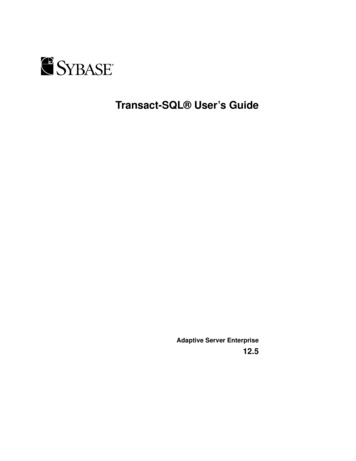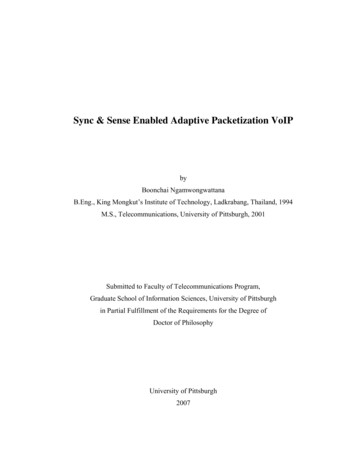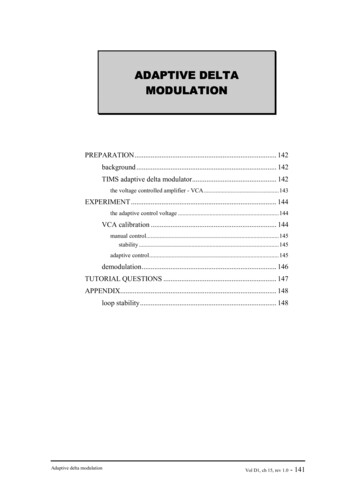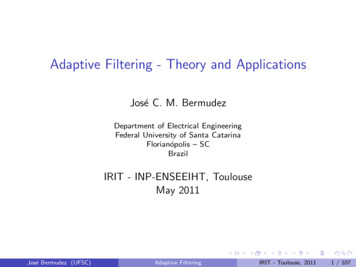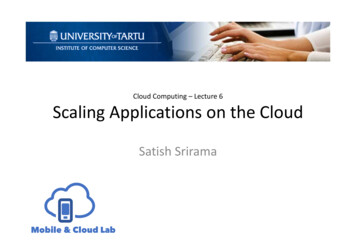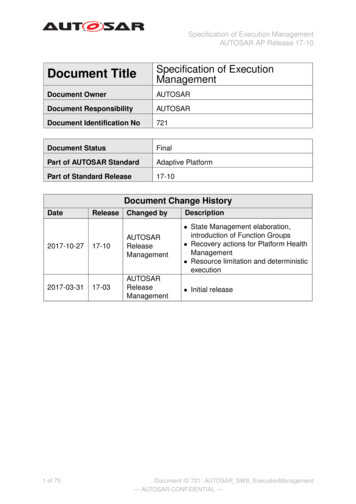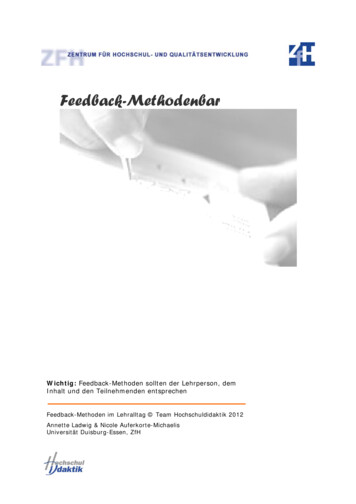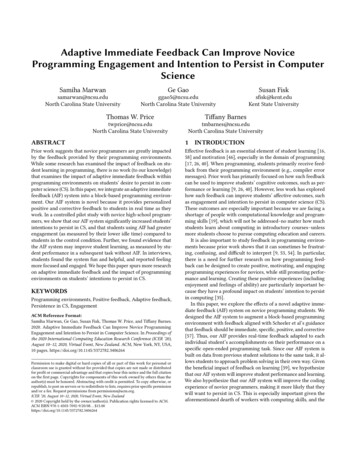
Transcription
Adaptive Immediate Feedback Can Improve NoviceProgramming Engagement and Intention to Persist in ComputerScienceSamiha MarwanGe GaoSusan Fisksamarwan@ncsu.eduNorth Carolina State Universityggao5@ncsu.eduNorth Carolina State Universitysfisk@kent.eduKent State UniversityThomas W. PriceTiffany Barnestwprice@ncsu.eduNorth Carolina State Universitytmbarnes@ncsu.eduNorth Carolina State UniversityABSTRACT1Prior work suggests that novice programmers are greatly impactedby the feedback provided by their programming environments.While some research has examined the impact of feedback on student learning in programming, there is no work (to our knowledge)that examines the impact of adaptive immediate feedback withinprogramming environments on students’ desire to persist in computer science (CS). In this paper, we integrate an adaptive immediatefeedback (AIF) system into a block-based programming environment. Our AIF system is novel because it provides personalizedpositive and corrective feedback to students in real time as theywork. In a controlled pilot study with novice high-school programmers, we show that our AIF system significantly increased students’intentions to persist in CS, and that students using AIF had greaterengagement (as measured by their lower idle time) compared tostudents in the control condition. Further, we found evidence thatthe AIF system may improve student learning, as measured by student performance in a subsequent task without AIF. In interviews,students found the system fun and helpful, and reported feelingmore focused and engaged. We hope this paper spurs more researchon adaptive immediate feedback and the impact of programmingenvironments on students’ intentions to persist in CS.Effective feedback is an essential element of student learning [16,58] and motivation [46], especially in the domain of programming[17, 26, 40]. When programming, students primarily receive feedback from their programming environment (e.g., compiler errormessages). Prior work has primarily focused on how such feedbackcan be used to improve students’ cognitive outcomes, such as performance or learning [9, 26, 40]. However, less work has exploredhow such feedback can improve students’ affective outcomes, suchas engagement and intention to persist in computer science (CS).These outcomes are especially important because we are facing ashortage of people with computational knowledge and programming skills [19], which will not be addressed–no matter how muchstudents learn about computing in introductory courses–unlessmore students choose to pursue computing education and careers.It is also important to study feedback in programming environments because prior work shows that it can sometimes be frustrating, confusing, and difficult to interpret [9, 53, 54]. In particular,there is a need for further research on how programming feedback can be designed to create positive, motivating, and engagingprogramming experiences for novices, while still promoting performance and learning. Creating these positive experiences (includingenjoyment and feelings of ability) are particularly important because they have a profound impact on students’ intention to persistin computing [35].In this paper, we explore the effects of a novel adaptive immediate feedback (AIF) system on novice programming students. Wedesigned the AIF system to augment a block-based programmingenvironment with feedback aligned with Scheeler et al’s guidancethat feedback should be immediate, specific, positive, and corrective[57]. Thus, our AIF provides real-time feedback adapted to eachindividual student’s accomplishments on their performance on aspecific open-ended programming task. Since our AIF system isbuilt on data from previous student solutions to the same task, it allows students to approach problem solving in their own way. Giventhe beneficial impact of feedback on learning [59], we hypothesizethat our AIF system will improve student performance and learning.We also hypothesize that our AIF system will improve the codingexperience of novice programmers, making it more likely that theywill want to persist in CS. This is especially important given theaforementioned dearth of workers with computing skills, and theKEYWORDSProgramming environments, Positive feedback, Adaptive feedback,Persistence in CS, EngagementACM Reference Format:Samiha Marwan, Ge Gao, Susan Fisk, Thomas W. Price, and Tiffany Barnes.2020. Adaptive Immediate Feedback Can Improve Novice ProgrammingEngagement and Intention to Persist in Computer Science. In Proceedings ofthe 2020 International Computing Education Research Conference (ICER ’20),August 10–12, 2020, Virtual Event, New Zealand. ACM, New York, NY, USA,10 pages. https://doi.org/10.1145/3372782.3406264Permission to make digital or hard copies of all or part of this work for personal orclassroom use is granted without fee provided that copies are not made or distributedfor profit or commercial advantage and that copies bear this notice and the full citationon the first page. Copyrights for components of this work owned by others than theauthor(s) must be honored. Abstracting with credit is permitted. To copy otherwise, orrepublish, to post on servers or to redistribute to lists, requires prior specific permissionand/or a fee. Request permissions from permissions@acm.org.ICER ’20, August 10–12, 2020, Virtual Event, New Zealand 2020 Copyright held by the owner/author(s). Publication rights licensed to ACM.ACM ISBN 978-1-4503-7092-9/20/08. . . UCTION
fact that many students with sufficient CS ability choose not tomajor in CS [31].We performed a controlled pilot study with 25 high school students, during 2 summer camps, to investigate our primary researchquestion: What impact does adaptive immediate feedback (AIF)have on students’ perceptions, engagement, performance, learning,and intentions to persist in CS? In interviews, students found AIFfeatures to be engaging, stating that it was fun, encouraging, andmotivating. Our quantitative results show that in comparison tothe control group, our AIF system increased students’ intentionsto persist in CS, and that students who received the AIF were significantly more engaged with the programming environment, asmeasured by reduced idle time during programming. Our resultsalso suggest that the AIF system improved student performance byreducing idle time, and that the AIF system may increase novicestudents’ learning, as measured by AIF students’ performance in afuture task with no AIF.In sum, the key empirical contributions of this work are: (1)a novel adaptive immediate feedback system, and (2) a controlledstudy that suggests that programming environments with adaptiveimmediate feedback can increase student engagement and intentionto persist in CS. Since the AIF is built based on auto-grader technologies, we believe that our results can generalize to novices learningin other programming languages and environments. This researchalso furthers scholarship on computing education by drawing attention to how programming environments can impact persistencein computing.2RELATED WORKResearchers and practitioners have developed myriad forms of automated programming feedback. Compilers offer the most basicform of syntactic feedback through error messages, which canbe effectively enhanced with clearer, more specific content [8, 9].Additionally, most programming practice environments, such asCodeWorkout [23] and Cloudcoder [29], offer feedback by runninga student’s code through a series of test cases, which can either passor fail. Other autograders (e.g. [5, 62]) use static analysis to offerfeedback in block-based languages, which do not use compilers.Researchers have improved on this basic correctness feedback withadaptive on-demand help features, such as misconception-drivenfeedback [26], expert-authored immediate feedback [27], and automated hints [52, 56], which can help students identify errors andmisconceptions or suggest next steps. This additional feedback canimprove students’ performance and learning [17, 26, 40]. However,despite these positive results, Aleven et al. note that existing automated feedback helps “only so much” [1]. In this section, we explorehow programming feedback could be improved by incorporatingbest practices, and why this can lead to improvements in not onlycognitive but also affective outcomes.Good feedback is critically important for students’ cognitiveand affective outcomes [46, 47, 58] – but what makes feedbackgood? Our work focuses on task-level, formative feedback, givento students as they work, to help them learn and improve. In areview of formative feedback, Shute argues that effective feedbackis non-evaluative, supportive, timely, and specific [58]. Similarly, ina review on effective feedback characteristics, Scheeler et al. notedthat feedback should be immediate, specific, positive, and correctiveto promote lasting change in learners’ behaviors [57]. Both reviewsemphasize that feedback, whether from an instructor or a system,should support the learner and provide timely feedback accordingto students’ needs. However, existing programming feedback oftenfails to address these criteria.Timeliness: Cognitive theory suggests that immediate feedbackis beneficial, as it results in more efficient retention of information[50]. While there has been much debate over the merits of immediate versus delayed feedback, immediate feedback is often moreeffective on complex tasks, when students have less prior knowledge [58], making it appropriate for novice programmers. In mostprogramming practice environments, however, students are expected to work without feedback until they can submit a mostlycomplete (if not correct) draft of their code. They then receive delayed feedback, from the compiler, autograder or test cases. Evenif students choose to submit code before finishing it, test casesare not generally designed for evaluating partial solutions, as theyrepresent correct behavior, rather than subgoals for the overalltask. Other forms of feedback, such as hints, are more commonlyoffered on-demand [41, 56]. While these can be used for immediatefeedback, this requires the student to recognize and act on theirneed for help, and repeated studies have shown that novice programmers struggle to do this [39, 53]. In contrast, many studieswith effective programming feedback have used more immediatefeedback. For example, Gusukuma et al. evaluated their immediate,misconception-driven feedback in a controlled study with undergraduate students, and found it improved students performance onopen-ended programming problems [26].Positiveness: Positive feedback is an important way that peoplelearn, through confirmation that a problem-solving step has beenachieved appropriately, e.g. “Good move” [7, 21, 25, 36]. Mitrovic etal. theorized that positive feedback is particularly helpful for noviceprogrammers, as it reduces their uncertainty about their actions[43], and this interpretation is supported by cognitive theories aswell [3, 4]. However, in programming, the feedback students receive is rarely positive. For example, enhanced compiler messages[9] improve on how critical information is presented, but offer noadditional feedback when students’ code compiles correctly. Similarly automated hints [40] and misconception-driven feedback [26]highlight what is wrong, rather than what is correct about students’code. This makes it difficult for novices to know when they havemade progress, which can result in students deleting correct code,unsure if it is correct [45]. Two empirical studies in programmingsupport the importance of positive feedback. Fossati et al. foundthat the iList tutor with positive feedback improved learning, andstudents liked it more than iList without it [25]. An evaluation ofSQL tutor showed that positive feedback helped students masterskills in less time [43].While there is a large body of work exploring factors influencingstudents’ affective outcomes, like retention [10] or intentions topersist in CS major [6], few studies have explored how automatedtools can improve these outcomes [24]. There is ample evidence thatimmediate, positive feedback would be useful to students; however,few feedback systems offer either [25]. More importantly, evaluations of these systems have been limited only to cognitive outcomes;
however, prior work suggests that feedback should also impact students’ affective outcomes such as their engagement and intentionto persist. For example, a review of the impact of feedback on persistence finds that positive feedback “increases motivation whenpeople infer they have greater ability to pursue the goal or associatethe positive experience with increased goal value” [24]. Positivefeedback has also been found to improve student confidence, and isan effective motivational strategy used by human tutors [34]. Additionally, in other domains feedback has been shown to increasestudents’ engagement [49]. This suggests not only the need forthe design of feedback that embraces these best practices, but alsoevaluation of its impact on cognitive and affective outcomes.3ADAPTIVE IMMEDIATE FEEDBACK (AIF)SYSTEMOur adaptive immediate feedback (AIF) system was designed to provide high-quality feedback to students as they are learning to codein open-ended programming tasks (e.g. PolygonMaker and DaisyDesign, described in more detail in Section 4.2). Our AIF systemcontinuously and adaptively confirms when students complete (orbreak) meaningful objectives that comprise a larger programmingtask. Importantly, a student can complete AIF objectives withouthaving fully functional or complete code. This allows us to offerpositive and corrective feedback that is immediate and specific. Inaddition, our AIF system includes pop-up messages tailored to ourstudent population, since personalization is key in effective humantutoring dialogs [12, 21] and has been shown to improve novices’learning [33, 44].Our AIF system consists of three main components to achievereal-time adaptive feedback: objective detectors, a progress panel,and pop-up messages. The objective detectors are a set of continuousautograders focused on positive feedback, that continuously checkstudent code in real time to determine which objective studentsare working on and whether they have correctly achieved it or not.The progress panel is updated by the continuous objective detectorsto color each task objective according to whether they are complete(green), not started (grey), or broken (red), since prior researchsuggests that students who were uncertain often delete their correctcode [22]. The pop-up messages leverage the objective detectorsto provide achievement pop-ups when objectives are completed,and motivational pop-ups when a student has not achieved anyobjectives within the last few minutes. These pop-ups promoteconfidence by praising both accomplishment and perseverance,which may increase students’ persistence [15]. We strove to makethe AIF system engaging and joyful, which may increase students’motivation and persistence [30].To develop our AIF system, we first developed task-specific objective detectors, which can be thought of as continuous real-timeautograders, for each programming task used in our study. Unlikecommon autograders which are based on instructors’ test cases,our objective detectors are hand-authored to encompass a largevariety of previous students’ correct solutions matching variousstudents’ mindsets. To do so, two researchers with extensive experience in grading block-based programs, including one instructor,divided each task into a set of 4-5 objectives that described featuresof a correct solution, similar to the process used by Zhi et al. [65].Figure 1: Adaptive Immediate Feedback (AIF) system withpop-up message (top) and progress dialog (bottom right),added to iSnap [52].Table 1: Examples of Pop-up Messages in the AIF System.State 1/2 objectives completemessage 1/2 objectives complete- You’re on fire!All objectives are doneFixed broken objective- High FIVE!!Struggle/Idle , half done- Yeat it till you beat it!!Struggle/Idle, half done- You are doing great so far!!- You are legit amazing!!- Yay!!!!, you DID IT!!it’s fixed!!Then, for each task, we transferred prior students’ solutions intoabstract syntax trees (AST). Using these ASTs, we detected differentpatterns that resemble a complete correct objective, and accordingly, we developed objective detectors to detect the completion foreach objective. Finally, we tested and enhanced the accuracy of theobjective detectors by manually verifying their performance andrefining them until they correctly identified objective completionon 100 programs written by prior students.Based on the objective detectors, we designed the progress panelto show the list of objectives with colored progress indicators, asshown in the bottom right of Figure 1. Initially, all the objectivesare deactivated and grey. Then, while students are programming,the progress panel adaptively changes its objectives’ colors basedon students’ progress detected by our objective detectors. Oncean objective is completed, it becomes green, but if it is broken, itchanges to red.We then designed personalized AIF pop-up messages. We askedseveral high school students to collaboratively construct messagesfor a friend to (1) praise achievement upon objective completion, or(2) provide motivation when they are struggling or lose progress.The final messages shown in Table 1 include emojis added to increase positive affect [20, 55]. In real time, our AIF system selects acontextualized pop-up message based on students’ code and actions,detected by our objective detectors. The pop-up messages providedimmediate adaptive feedback, such as “Woo, one more to go!!” fora student with just one objective left, or “Good job, you FIXED it!!
;)” when a student corrected a broken objective. To praise perseverance, AIF pop-ups are also shown based on time, either after someidle time, or if a student takes longer than usual on an objectivebased on previous student data. It may be especially important toprovide affective support to students who may be struggling. Forexample, if a student stopped editing for more than 2 minutes1and they are half-way through the task, one motivational pop-upmessage is “Keep up the great work !!”.Our novel AIF system is the first such system to include continuous real-time autograding through objective detectors, and is thefirst to use such detectors to show students a progress panel fortask completion in open-ended programming tasks. Further, ourAIF pop-up message system is the first such system that providesboth immediate, achievement-based feedback as well as adaptiveencouragement for students to persist. The AIF system was addedto iSnap, a block-based programming environment [52], but couldbe developed based on autograders for most programming environments.3.1Illustrative Example: Jo’s Experience withthe AIF SystemTo illustrate a student’s experience with the AIF system and makeits features more concrete, we describe the observed experienceof Jo, a high school student who participated in our study, as described in detail in Section 4. On their first task to create a programto draw a polygon (PoygonMaker), Jo spent 11 minutes, requestedhelp from the teacher, and received 3 motivational and 2 achievement pop-up messages. As is common with novices new to theblock-based programming environment, Jo initially spent 3 minutes interacting with irrelevant blocks. Jo then received a positivepop-up message, “Yeet it till you beat it”. Over the next fewminutes, Jo added 3 correct blocks and received a few similar encouraging pop-up messages. Jo achieved the first objective, whereAIF marked it as complete and showed the achievement pop-up“You are on fire!.” Jo was clearly engaged, achieving 2 moreobjectives in the next minute. Over the next 3 minutes, Jo seemedto be confused or lost, repetitively running the code with differentinputs. After receiving the motivational pop-up “You’re killing it!,” Jo reacted out loud by saying “that’s cool”. One minutelater, Jo completed the 4th objective and echoed the pop-up “Yourskills are outta this world !!, you DID it!! ,”’ saying, “Yay, I didit.” Jo’s positive reactions, especially to the pop-up messages, andrepeated re-engagement with the task, indicate that AIF helped thisstudent stay engaged and motivated. This evidence of engagementaligns with prior work that measures students’ engagement witha programming interface by collecting learners’ emotions duringprogramming [38].Jo’s next task was to draw a DaisyDesign, which is more complex, and our adaptive immediate feedback seemed to help Jo overcome difficulty and maintain focus. AIF helped Jo stay on task byproviding a motivational pop-up after 3 minutes of unproductivework. In the next minute, Jo completed the first two objectives. AIFupdated Jo’s progress and gave an achievement pop-up, “You’rethe G.O.A.T2 ”. Jo then did another edit, and AIF marked apreviously-completed objective in red – demonstrating its immediate corrective feedback. Jo immediately asked for help and fixedthe broken objective. After receiving the achievement pop-up “Yeet,gottem!!,” Jo echoed it out loud. Jo spent the next 13 minutesworking on the 3rd objective with help from the teacher and peers,and 3 motivational AIF pop-ups. While working on the 4th andfinal objective over the next 5 minutes, Jo broke the other threeobjectives many times, but noticed the progress panel and restoredthem immediately. Finally, Jo finished the DaisyDesign task, saying “the pop-up messages are the best.” This example from a realstudent’s experience illustrates how we accomplished our goals toimprove engagement (e.g. maintaining focus on important objectives), student perceptions (e.g. stating “that’s cool”), performance(e.g. understanding when objectives were completed), and programming behaviors (e.g. correcting broken objectives).4METHODSWe conducted a controlled, pilot study during two introductory CSsummer camps for high school students. Our primary researchquestion is: What impact does our adaptive immediate feedback(AIF) system have on novice programmers? Specifically, we hypothesized that the AIF system would be positively perceived bystudents (H1-qual) and that the AIF system would increase: students’ intentions to persist in CS (H2-persist), student’ engagement(H3-idle), programming performance (H4-perf), and learning (H5learning). We investigated these hypotheses using data gleanedfrom interviews, system logs, and surveys.4.1ParticipantsParticipants were recruited from two introductory CS summercamps for high school students. This constituted an ideal populationfor our study, as these students had little to no prior programmingexperience or CS courses, allowing us to test the impact of the AIFsystem on students who were still learning the fundamentals ofcoding and who had not yet chosen a college major. Both campstook place on the same day at a research university in the UnitedStates.We combined the camp populations for analysis, since the campsused the same curriculum for the same age range. Study procedureswere identical across camps. The two camps consisted of one campwith 14 participants, (7 female, 6 male, and 1 who preferred not tospecify their gender) and an all-female camp with 12 participants.Across camps, the mean age was 14, and 14 students identified asWhite, 7 as Black or African American, 1 as Native American orAmerican Indian, 2 as Asian, and 1 as Other. None of the studentshad completed any prior, formal CS classes. Our analyses onlyinclude data from the twenty-five participants who assented–andwhose parents consented–to this IRB-approved study.4.2ProcedureWe used an experimental, controlled pre-post study design, whereinwe randomly assigned 12 students to the experimental group 𝐸𝑥𝑝(who used the AIF system), and 13 to the 𝐶𝑜𝑛𝑡𝑟𝑜𝑙 group (who used1 Weused a threshold of 2 minutes based on instructors’ feedback on students’ programming behavior.2 G.O.A.T.,an expression suggested by teenagers, stands for Greatest of All Time.
the block-based programming environment without AIF). The prepost measures include a survey on their attitudes towards theirintentions to persist in CS and a multiple choice test to assess basicprogramming knowledge. The teacher was unaffiliated with thisstudy and did not know any of the hypotheses or study details,including condition assignments for students. The teacher led anintroduction to block-based programming, and explained user input,drawing, and loops. Next, all students took the pre-survey andpretest.In the experimental phase of the study, students were asked tocomplete 2 consecutive programming tasks (1: PolygonMaker and2: DaisyDesign)3 . Task1, PolygonMaker, asks students to draw anypolygon given its number of sides from the user. Task2, DaisyDesign,asks students to draw a geometric design called “Daisy” which isa sequence of overlapping n circles, where n is a user input. Bothtasks required drawing shapes, using loops, and asking users toenter parameters, but the DaisyDesign task was more challenging.Each task consisted of 4 objectives, for a total of 8 objectives thata student could complete in the experimental phase of the study.Students in the experimental group completed these tasks with theAIF system, while students in the control group completed the sametask without the AIF system. All students, in both the experimentaland control groups, were allowed to request up to 5 hints from theiSnap system [52], and to ask for help from the teacher. In sum,there were eight objectives (as described in Section 3) that studentscould complete in this phase of the experiment (the experimentalphase). We measured a student’s programming performance basedon their ability to complete these eight objectives (see Section 4.3,below for more details).After each student reported completing both tasks4 , teachersdirected students to take the post-survey and post-test. Two researchers then conducted semi-structured 3-4 minute interviewswith each student. During the interviews with 𝐸𝑥𝑝 students, researchers showed students each AIF feature and asked what madeit more or less helpful, and whether they trusted it. In addition, theresearchers asked students’ opinions on the AIF design and how itcould be improved.Finally, all students were given 45 minutes to do a third, similar,but much more challenging, programming task (DrawFence) with5 objectives without access to hints or AIF. Learning was measuredbased on a student’s ability to complete these five objectives (seesubsection 4.3, below for more details).4.3MeasuresPretest ability - Initial computing ability was measured using anadapted version of Weintrop, et al.’s commutative assessment [64]with 7 multiple-choice questions asking students to predict theoutputs for several short programs. Across both conditions, themean pre-test score was 4.44 (SD 2.39; min 0; max 7).Engagement - Engagement was measured by using the percentof programming time that students’ spent idle (i.e. not engaged) ontasks 1 and 2. While surveys are often used to measure learners’engagement, these self-report measures are not always accurate,3 s://go.ncsu.edu/study instructions icer204 While all students reported completing both tasks, we found some students did notfinish the tasks after looking at their log data.and our fine-grained programming logs give us more detailed insight into the exact time students were, and were not, engaged withprogramming. To calculate percent idle time, we defined idle timeas a period of 3 or more minutes5 that a student spent without making edits or interacting with the programming environment, anddivided this time by the total time a student spent programming. Astudent’s total programming time was measured from when theybegan programming to task completion, or the end of the programming session if it was incomplete. While we acknowledge that some“idle” time may have been spent productively (e.g., by discussing theassignment with the teacher or peers), we observed this very rarely(despite Jo’s frequent help from friends and the teacher). Acrossboth conditions, the mean percent idle time on tasks 1 and 2 was13.9% (Mean 0.139; SD 0.188; min 0; max 0.625).Programming Performance - Programming performance wasmeasured by objective completion during the experimental phaseof the study (i.e., the first eight objectives in which the experimentalgroup used the AIF system). Each observed instance of programming performance was binary (e.g., the object was completed [valueof ‘1’] or the object was not completed [value of ‘0’]). This led to arepeated measures design, in which observations (i.e., whether anobject was or was not completed) were nested within participants,as each participant attempted 8 objectives (in sum, 200 observations were nested within 25 participants). We explain our analyticalapproach in more detail below. Across both conditions, the meanprogramming performance was 0.870 (min 0 ; max 1).Learning - Learning was measured by objective completionduring the last phase (the learning phase) of the study, on the lastfive objectives in which neither group used the AIF system, becausewe assumed that students who learned more would perform betteron this DrawFence task. Each observed instance of programmingperformance was binary. This led to a repeated measures design,in which observations (e.g., whether an objective was or was notcompleted) were nested within participants, as each participantattempted 5 objectives. In sum, 125 observations were nested within25 participants. Across both conditions, the mean learning scorewas 0.60 (min 0; max 1), meaning that, on average, studentscompleted about 3 of the 5 objectives.Intention to Persist - CS persi
Programming Engagement and Intention to Persist in Computer Science Samiha Marwan samarwan@ncsu.edu North Carolina State University Ge Gao ggao5@ncsu.edu North Carolina State University Susan Fisk sfisk@kent.edu Kent State University Thomas W. Price twprice@ncsu.edu North Carolina State University Tiffany Barnes tmbarnes@ncsu.edu North Carolina .
